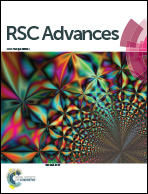Large disk electrodes of Ti/TiO2-nanotubes/PbO2 for environmental applications†
Abstract
Large disk electrodes of Ti/TiO2-nanotubes/PbO2 (65 cm2 of geometrical area) were successfully synthesized by anodization and electrodeposition procedures. Characterization of anodes was performed by SEM, EDS, AFM and electrochemical measurements, aiming towards environmental applications. PbO2, an electrocatalytic material, promotes the production of strong oxidising species (hydroxyl radicals) that can be used for decontamination. Electrochemical treatment of synthetic dye effluent (2 L) containing 250 mg L−1 of Acid Blue 113 dye (AB 113) was performed using a disk Ti/TiO2-nanotubes/PbO2 anode and an electrochemical flow cell. More than 85% of organic matter was removed by applying current densities of 20, 40 and 60 mA cm−2. Moreover, colour decay achieved values of 60%, 90% and 100%, depending on the applied current density. Alternatively, this study allows us to understand how nanomaterials have prevented the corrosion phenomena on the anode surface (Pb2+ pollution) due to the homogeneous migration of PbO2 within the TiO2 nanotubes previously formed on the Ti support.


 Please wait while we load your content...
Please wait while we load your content...